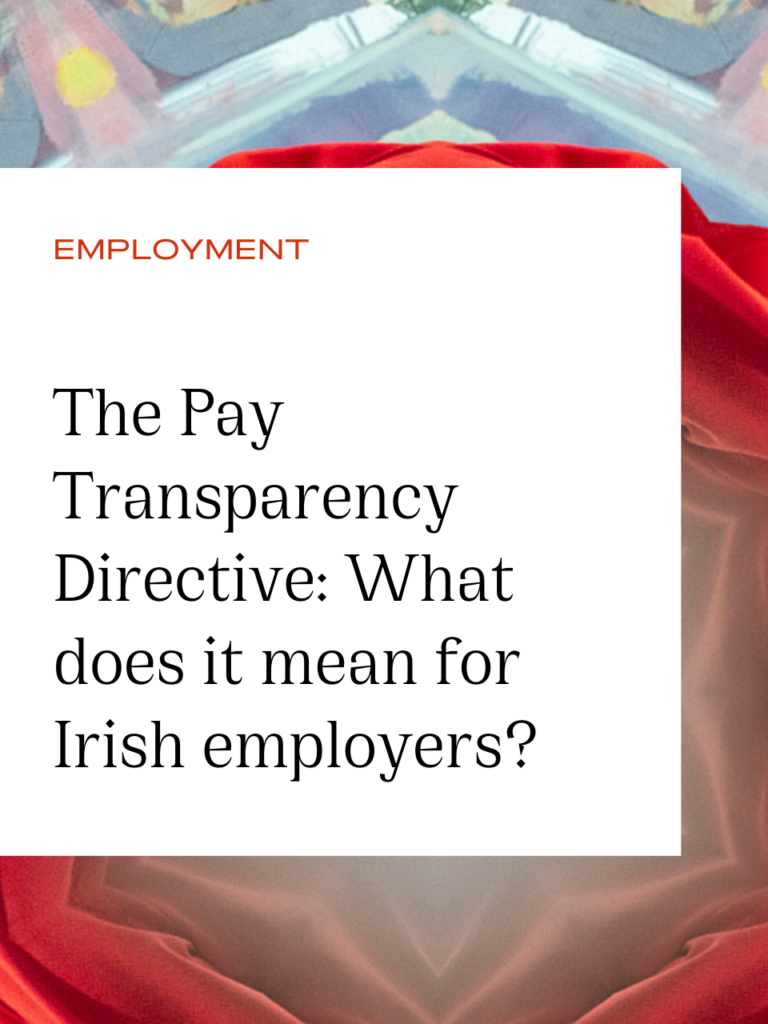The aim of the Directive is part of a wider EU strategy seeking to tackle concerns about the enforcement of the principle of equal pay between men and women by eliminating pay secrecy, promoting transparency in pay setting and career progression and strengthening enforcement mechanisms. There are three core measures provided for in the Directive:
- Implementing public reporting measures (for larger companies);
- Creating new information rights (for everybody); and
- Refreshing the concepts of the equal pay regime.
Employers now have three years to prepare for the implementation of the Directive in Ireland.
Public Reporting Obligations
Public reporting obligations for larger organisations (those with more than 250 employees initially) is an important transparency pillar implemented by the Directive. Ireland has had mandatory gender pay gap reporting since 2022 that largely meets the requirements of the Directive. However, there are some important new requirements that will require further legislation.
A major change is the nature of the data to be reported on. Irish gender pay gap reporting requires the data to be presented based on gender: there is no additional legal requirement to break down the data into different areas of the business. However, the Directive requires employers to report on the gender pay gap between “categories of workers” broken down by basic and variable pay. This might, for example, require a supermarket to show data on delivery drivers as compared to cash register operatives. While this additional data does not need to be made publicly available (given its sensitivity), it must be provided to employees, their representatives and potentially (subject to the implementing Irish legislation) the Workplace Relations Commission and Irish Human Rights and Equality Commission (“IHREC”).
Another significant change is the consequences arising from reporting. Currently, if an Irish employer’s data reveals a gender pay gap, it must publish a statement setting out the reasons, in its opinion, for the differences that are referable to gender, and the measures it is taking or will take to remedy the difference. Under the Directive, where there is a gender pay gap of 5% or more between any category of worker and this cannot be objectively justified on a gender-neutral basis, it triggers the more onerous “joint pay assessment” procedure.
Conducting a joint pay assessment will require an employer to carry out a detailed analysis of all categories of workers, set out measures to address unjustified differences, and report on the effectiveness of any previous measures taken. This will then have to be provided to workers, their representatives, and the labour inspectorate and equality and monitoring bodies. The employer must then, in close co-operation with those representatives and labour and equalities bodies remedy the situation, particularly by establishing gender neutral job evaluations and classifications.
New Transparency Obligations
The Directive also creates a range of new obligations for employers of all sizes. Most of these obligations concern the elimination of pay and progression secrecy.
Pay transparency prior to employment
Employers will have to provide information about salary levels or ranges either in the job advertisement or in advance of the interview, without the candidate having to ask for it. Furthermore, employers will be prohibited from asking applicants about their own pay history.
Pay transparency in employment
Employers will have to provide a gender neutral and easily accessible description of the criteria used to determine pay levels and career progression to their employees.
Right to request information breakdown
Any employee will be able to ask their employer for information concerning their individual pay level and the average pay levels, broken down by “sex”, for categories of workers performing the same work as them or work of equal value to them. An employer must provide this information within two months of receiving such a request and must also remind employees annually of their right to request this data. Employees can ask for the information directly or through their representatives or an equality body (potentially, IHREC).
Confidentiality
Employees will not be prevented from disclosing their pay for the purpose of enforcing the principle of equal pay. Employers will, however, will be permitted to require that any information obtained by an employee pursuant to the right to information can only be used to exercise their right to equal pay and that it cannot be otherwise disseminated.
Refreshing the Concepts of the Equal Pay Regime
One of the central aims of the Directive is to clarify legal concepts such as “pay”, “discrimination” and “work of equal value”, particularly given the volume of case law on these issues since the concept of equal pay was established in the Treaty of Rome in 1957. Some interesting new features are:
Intersectionality
Pay discrimination under the Directive includes discrimination based on a combination of sex and any other protected ground. It remains to be seen whether this will amount to a more substantial protection for employees in practice.
Comparators
The Directive requires member states to remove the strict requirement to identify a real comparator to bring an equal pay claim. It provides that where no real comparator can be established for an equal pay claim, an employee can use a hypothetical comparator or provide other evidence instead. This is a major departure from the current position; historically, the requirement to name a specific comparator has caused procedural difficulties for complainants.
Comparing “Categories of Workers” and Defining “Work of Equal Value”
The pay transparency measures in the Directive require employers to identify respective “categories of workers” performing the same work (or work of equal value). Employers will be responsible for comparing roles to determine their respective “value”, but member states must ensure that tools and methodologies are established to allow employers to make this assessment.
Burden of proof
Under the Directive, the burden of proof is placed on an employer to prove that it has not discriminated against an employee in relation to pay. This is not currently the case for discrimination and equal pay claims, where an employee must first prove facts from which a presumption of discrimination can be drawn before the burden can shift back to the employer to provide that no discrimination has occurred.
Penalties
The equal pay regime in Ireland is currently focused on individual enforcement through equal pay claims. However, the Directive requires Member States to set out rules on effective penalties, including fines. There is a significant degree of leeway left to Member States to determine the nature of such rules.
What should employers consider doing now?
The changes to be implemented by the Pay Transparency Directive will result an increased compliance burden on employers. Employers should consider using the three-year period to conduct a “GAP Analysis” between their current state of readiness for the Directive and the expectations on them in three years’ time. Employers should consider:
- Reviewing current arrangements concerning remuneration and progression in the business to identify any gaps that may arise and consider when and how to address these gaps in line with the Directive;
- How “categories of workers” might be organised in the business and the basis on which such groupings can be defined;
- Whether changes to data storage and collection need to be made to allow information requests to be processed within a reasonable time frame;
- Running reports to ascertain whether any obvious gender pay gaps exist between categories of workers and, if they do, consider what measures can be implemented to address the size of the gender pay gap. For example, a large organisation with a gender pay gap of more than 5% between different categories of workers might to consider reviewing the reasons for that gap to take steps to address it before potentially being exposed to a joint pay assessment.
If you have any questions in relation to the Pay Transparency Directive, please contact a member of the Employment team at Arthur Cox.




